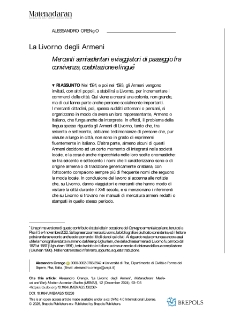Օբյեկտ
Վերնագիր: La Livorno degli Armeni
Հրապարակման մանրամասներ:
Ամսագրի կամ հրապարակման վերնագիր:
Matenadaran: Medieval and Early Modern Armenian Studies (MEMAS)
Հրապարակման ամսաթիվ:
Հատոր:
Համար:
ISSN:
Լրացուցիչ տեղեկություն:
սեղմիր այստեղ կապին հետևելու համար
Այլ վերնագիր:
Mercanti semisedentari e viaggiatori di passaggio fra convivenza, coabitazione e lingue
Աջակից(ներ):
Editor-in-Chief Aram Topchyan ; Managing Editor Ani Shahnazaryan
Ծածկույթ:
Ամփոփում:
Nel 1591, e poi nel 1593, gli Armeni vengono invitati, con altri popoli, a stabilirsi a Livorno, per incrementare i commerci della città. Qui viene a crearsi una colonia, non grande, ma di cui fanno parte anche persone socialmente importanti. I mercanti cittadini, poi, spesso sudditi ottomani o persiani, si organizzano in modo da avere un loro rappresentante, Armeno o Italiano, che funga anche da interprete. In effetti, il problema della lingua spesso riguarda gli Armeni di Livorno, tanto che, tra seicento e settecento, abbiamo testimonianze di persone che, pur vissute a lungo in città, non sono in grado di esprimersi fluentemente in italiano. D’altra parte, almeno alcuni di questi Armeni decidono ad un certo momento di integrarsi nella società locale, e la cosa è anche rispecchiata nelle loro scelte onomastiche: se tra seicento e settecento i nomi che li caratterizzano sono o di origine armena o di tradizione genericamente cristiana, con l’ottocento compaiono sempre più di frequente nomi che seguono la moda locale.
In 1591, and then again in 1593, Armenians were invited, along with other peoples, to settle in Leghorn (Livorno) and boost the city’s trade. Thus, a colony was created that, although not large, included socially prominent people. Later on, the city’s merchants, often Ottoman or Persian subjects, arranged to have a representative of their own — either an Armenian or an Italian — who could also act as an interpreter. Indeed, language(s) and communication were often a problem for Leghorn’s Armenians: between the seventeenth and eighteenth centuries, evidence exists of people who, despite having lived in the city for a long time, were unable to express themselves fluently in Italian. On the other hand, at least some of these Armenians eventually decided to integrate into the local society. This is also reflected in their naming practices: whereas between the seventeenth and eighteenth centuries the Leghorn Armenians bore either Armenian or generally Christian names, by the nineteenth century they increasingly adopted names that followed local fashion(s).
Հրատարակիչ:
Mesrop Mashtots Institute of Ancient Manuscripts
Ձևաչափ:
Նույնացուցիչ:
oai:arar.sci.am:422375
Լեզու:
Օբյեկտի հավաքածուներ:
Վերջին անգամ ձևափոխված:
Nov 6, 2025
Մեր գրադարանում է սկսած:
Nov 6, 2025
Օբյեկտի բովանդակության հարվածների քանակ:
1
Օբյեկտի բոլոր հասանելի տարբերակները:
https://arar.sci.am/publication/454895
Ցույց տուր նկարագրությունը RDF ձևաչափով:
Ցույց տուր նկարագրությունը OAI-PMH ձևաչափով։
-
Matenadaran: Medieval and Early Modern Armenian Studies (MEMAS)
-
Matenadaran: Medieval and Early Modern Armenian Studies (MEMAS), 2024, Vol 1, N 1
-
Matenadaran: Medieval and Early Modern Armenian Studies (MEMAS), 2024, Vol 1, N 2
- Editorial board
- Contents
- The Original Text Form and Chapters Order of the Physiologus, with an Edition of the Chapter on the Lizard
- A New, Critical Edition of Armenian Deuteronomy, Forty Years after Its “Diplomatic” Predecessor
- A Note on Armenian-Caucasian Albanian Contacts
- Translation of the Genitive Absolute in the Armenian Alexander Romance
- Diplomatic Correspondence of Armenian King Levon I with Egyptian Sultan al-Malik al-Adil (1208–1209)
- La Livorno degli Armeni
- “Medieval Violence” and Legal Issues of Everyday Life in Cilician Armenia (Late Twelfth–Fourteenth Centuries)
- A Gusan Gestalt Shift
- Armenian Amulet Scrolls in the Collections of Paris
- "Don't Forget about the Silver Covers!"
- Azat A. Bozoyan (ed.), Պատկերապաշտության և պատկերամարտության խնդիրը Հայաստանում և Բյուզանդիայում (ազգային ինքնության պահպանման համատեքստում). հոդվածների ժողովածու ; [The Problem of Iconoclasm and Iconolatry in Armenia and Byzantium (in the Context of Identity Preservation): Collection ofArticles], Yerevan: “Gitutyun” Publishing House of the Armenian Academy of Sciences, 2024.
- A List of Armenological Publications of 2024
-
Matenadaran: Medieval and Early Modern Armenian Studies (MEMAS), 2024, Vol 1, N 1
| Հրատարակության անուն | Ամսաթիվ |
|---|---|
| Orengo, Alessandro, La Livorno degli Armeni | Nov 6, 2025 |





